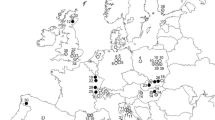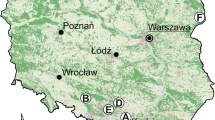Abstract
The house cat Felis catus was introduced to Australia as a pet and means of rodent control over 200 years ago, but now has established feral populations and has become a serious threat to native wildlife. Using stomach content analysis of 73 feral cats from semi-arid grassland habitats in Queensland, Australia, we aimed to identify dominant prey groups in the cats' diet and to explore associations between the diversity of prey eaten and attributes of the cats including body size, condition, sex, age and coat colour. We also sought to determine any relationships between cat size and the size of the dominant prey in the diet, the long-haired rat Rattus villosissimus. Mammals and reptiles were the dominant prey, with R. villosissimus occurring in 60 % of samples and comprising more than half of all prey by volume. Birds and terrestrial invertebrates were the next most important contributors to the diet, but fish, frogs and freshwater crustaceans also were surprisingly well represented. The dietary diversity of cats was largely unrelated to any of the cat attributes that we measured, although a positive relationship emerged between cat head width and the range of prey types eaten. Our study was conducted during a population irruption of R. villosissimus and confirms that cats are able to exploit an abundant focal prey resource when the opportunity occurs. Further research now is needed to explore associations between diet and cat attributes during periods when rats are scarce.



Similar content being viewed by others
References
Abbott I (2002) Origin and spread of the cat, Felis catus, on mainland Australia, with a discussion of the magnitude of its early impact on native fauna. Wildl Res 29:51–74
Adams PJ, Elliot AD, Algar D, Brazell RI (2008) Gastrointestinal parasites of feral cats from Christmas Island. Aust Vet J 86:60–63
AUSLIG (1990) Atlas of Australian resources: vegetation. Commonwealth Government Printer, Canberra
Bengsen A, Butler J, Masters P (2011) Estimating and indexing feral cat population abundances using camera traps. Wildl Res 38:732–739
Biro PA, Stamps JA (2009) Are animal personality traits linked to life-history productivity? Trends Ecol Evol 23:361–368
Blackwell GL, Bassett SM, Dickman CR (2006) Measurement error associated with external measurements commonly used in small-mammal studies. J Mammal 87:216–223
Bonnaud E, Bourgeois K, Vidal E, Kayser Y, Tranchant Y, Legrand J (2007) Feeding ecology of a feral cat population on a small Mediterranean island. J Mammal 88:1074–1081
Bureau of Meteorology (2012) Climate statistics for Australian locations: Longreach. http://www.bom.gov.au/climate/averages/tables/cw_036031.shtml Accessed 25 Sept 2012
Burrows N, Christensen P (1994) Hunting the hunter. Landscope 10:37–41
Childs JE (1986) Size-dependent predation on rats (Rattus norvegicus) by house cats (Felis catus) in an urban setting. J Mammal 67:196–199
Denny EA (2005) Ecology of free-living cats exploiting waste disposal sites: diet, morphometrics, population dynamics and population genetics. Dissertation, University of Sydney
Denny EA, Dickman CR (2010) Review of cat ecology and management strategies in Australia. Invasive Animals Cooperative Research Centre, Canberra
Denny E, Yakovlevich P, Eldridge MDB, Dickman CR (2002) Social and genetic analysis of a population of free-living cats (Felis catus L.) exploiting a resource-rich habitat. Wildl Res 29:405–413
Dickman CR (1988a) Age-related dietary change in the European hedgehog, Erinaceus europaeus. J Zool 215:1–14
Dickman CR (1988b) Body size, prey size, and community structure in insectivorous mammals. Ecology 69:569–580
Dickman CR (1996) Overview of the impacts of feral cats on Australian native fauna. Australian Nature Conservation Agency, Canberra
Dickman CR (2009) House cats as predators in the Australian environment: impacts and management. Human-Wildl Conflicts 3:41–48
Dickman CR, Greenville AC, Beh C-L, Tamayo B, Wardle GM (2010) Social organization and movements of desert rodents during population “booms” and “busts” in central Australia. J Mammal 91:798–810
Dickman CR, Huang C (1988) The reliability of fecal analysis as a method for determining the diet of insectivorous mammals. J Mammal 69:108–113
Driscoll CA, Menotti-Raymond M, Roca AL et al (2007) The near Eastern origin of cat domestication. Science 317:519–523
D'Souza JB, Whittington A, Dickman CR, Leung LK-P (2013) Perfect storm: demographic responses of an irruptive desert mammal to prescribed burns following flooding rain. Austral Ecol 38 (in press)
Fitzgerald BM, Karl BJ (1979) Foods of feral house cats (Felis catus L.) in forest of the Orongorongo Valley, Wellington. New Zeal J Zool 6:107–126
Fitzgerald BM, Turner DC (2000) Hunting behaviour of domestic cats and their impact on prey populations. In: Turner DC, Bateson P (eds) The domestic cat: the biology of its behaviour. Cambridge University Press, Cambridge, pp 149–175
Greenville AC, Wardle GM, Dickman CR (2013) Extreme rainfall events predict irruptions of rat plagues in central Australia. Aust Ecol 38 (in press)
Hart RK, Calver MC, Dickman CR (2002) The index of relative importance: an alternative approach to reducing bias in descriptive studies of animal diets. Wildl Res 29:415–421
Hochstrasser G (1970) Hauskatze frisst heuschrecken zur Sattigung. Saugetierk Mitt 18:278
Kutt AS (2011) The diet of the feral cat (Felis catus) in north-eastern Australia. Acta Theriol 56:157–169
Kutt AS (2012) Feral cat (Felis catus) prey size and selectivity in north-eastern Australia: implications for mammal conservation. J Zool 287:292–300
McLachlan-Troup TA, Dickman CR, Grant TR (2010) Diet and dietary selectivity of the platypus in relation to season, sex and macroinvertebrate assemblages. J Zool 280:237–246
Medina FM, Garcia R, Nogales M (2006) Feeding ecology of feral cats on a heterogeneous subtropical oceanic island (La Palma, Canarian Archipelago). Acta Theriol 51:75–83
Mifsud G, Woolley PA (2012) Predation of the Julia Creek dunnart (Sminthopsis douglasi) and other native fauna by cats and foxes on Mitchell grass downs in Queensland. Aust Mammal 34:188–195
Molsher R, Newsome A, Dickman C (1999) Feeding ecology and population dynamics of the feral cat (Felis catus) in relation to the availability of prey in central-eastern New South Wales. Wildl Res 26:593–607
Paltridge R (2002) The diets of cats, foxes and dingoes in relation to prey availability in the Tanami Desert, Northern Territory. Wildl Res 29:389–403
Paltridge R, Gibson D, Edwards G (1997) Diet of the feral cat in central Australia. Wildl Res 24:67–76
Pavey CR, Eldridge SR, Heywood M (2008) Population dynamics and prey selection of native and introduced predators during a rodent outbreak in arid Australia. J Mammal 89:674–683
Pearre S, Maass R (1998) Trends in the prey size-based trophic niches of feral and house cats Felis catus L. Mamm Rev 28:125–139
Pielou EC (1975) Ecological diversity. Wiley Interscience, New York
Pinkas L, Oliphant MS, Iverson ILK (1971) Food habits of albacore, bluefin tuna, and bonito in California waters. Fish Bull 152:1–105
Predavec M, Dickman CR (1994) Population dynamics and habitat use of the long-haired rat (Rattus villosissimus) in south-western Queensland. Wildl Res 21:1–10
Quinn GP, Keough MJ (2002) Experimental design and data analysis for biologists. Cambridge University Press, Cambridge
Read J, Bowen Z (2001) Population dynamics, diet and aspects of the biology of feral cats and foxes in arid South Australia. Wildl Res 28:195–203
Risbey DA, Calver MC, Short J, Bradley JS, Wright IW (2000) The impact of cats and foxes on the small vertebrate fauna of Heirisson Prong, Western Australia. II. A field experiment. Wildl Res 27:223–235
Short J, Turner B, Risbey D (2002) Control of feral cats for nature conservation. II. Trapping. Wildl Res 29:475–487
Stephens DW, Krebs JR (1986) Foraging theory. Princeton University Press, New Jersey
Triggs B, Brunner H, Cullen JM (1984) The food of the fox, dog and cat in Croajingalong National Park, south-eastern Victoria. Aust Wildl Res 11:491–499
VSN International (2011) GenStat for Windows, 14th edn. VSN International, Hemel Hempstead
Watson K (2006) Aspects of the history, home range and diet of the feral cat (Felis catus) in the Perisher Range resort area of Kosciuszko National Park, New South Wales. Dissertation, University of Sydney
Acknowledgments
We are very grateful to Alicia Whittington, Shane Hume, Maree Rich and other staff of Queensland National Parks at Longreach for providing all the cat specimens for this work. We also thank Bobby Tamayo for assistance in retrieving and storing cat specimens, Matthew Greenlees and Glenn Shea for expert assistance with identification of stomach contents, and Mathew Crowther and Peter Thomson for provision of statistical advice.
Author information
Authors and Affiliations
Corresponding author
Additional information
Communicated by: Krzysztof Schmidt
Rights and permissions
About this article
Cite this article
Yip, S.J.S., Dickman, C.R., Denny, E.A. et al. Diet of the feral cat, Felis catus, in central Australian grassland habitats: do cat attributes influence what they eat?. Acta Theriol 59, 263–270 (2014). https://doi.org/10.1007/s13364-013-0166-5
Received:
Accepted:
Published:
Issue Date:
DOI: https://doi.org/10.1007/s13364-013-0166-5




